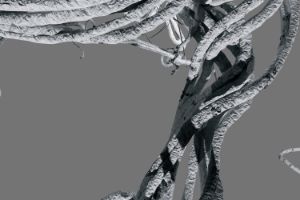Concert
Interpoiesis 3

Visual concept & design: Eps51, Berlin
The concert series “Interpoiesis” in silent green’s Kuppelhalle facilitates multi-generational and intersectional musical encounters of artists from diverse backgrounds who have never collaborated with each other before.
“Interpoiesis” is a concert series that presents new projects arising from multi-generational and intersectional collaborative encounters between artists from diverse backgrounds. “Interpoiesis” denotes an interstice of co-creation, in reference to Donna Haraway’s notion of “sympoiesis” (“making-with”) as the condition of always doing in relation to other(s), the impossibility of creating anything alone.
MaerzMusik invites four constellations of artists to propose a collaborator they have not worked with before, and share their conversations and processes in and through sound and performance. The four concerts display different stages of co-creations, from finalised works to intermediary results of collaborative processes to open experimentations that challenge preconceived roles and relations within the spectrum of artistic and social practices.
The Sheng, a mouth organ made from bamboo reeds with a history thousands of years old, is the focus of the research and the musical projects of the composer and Sheng virtuoso Wu Wei and the sound director Alexis Baskind who began an interaction with the light designer Katrin Bethge for the third edition of the concert series “Interpoiesis”.
As the embodiment of the harmony between heaven, earth, and human being, the Sheng was primarily used in sacral contexts in classical Chinese music. Following traditional pieces, amongst others from the Song dynasty and the Japanese court music gagaku, compositions followed in China in 1956 for the modernised mouth organ as well as increasing numbers of contemporary pieces since the 1970s. Alongside its history, acoustics and organology, it is mainly the musical analysis and an expansion of its acoustic possibilities over the course of tradition-overlapping composition that Wu and Baskind are researching in their project “Forêt de Bambous” (Pfeifenwald), which has existed since 2021. How can a new perspective for this instrument, mostly presented as a sound object, be created so that the audience does not experience it as a separate source of sound but instead be immersed within it using a spatial restructuring and an acoustic and electronic sound system?
In collaboration with the light designer Katrin Bethge, an auditory and aesthetic space of a “bamboo forest” has been created that shifts the listening perspective of the audience into the inside of the Sheng and, at the same time, makes a new sorting of the poles of interpreters, piece and listeners possible.
“Forêt de Bambous” (Pfeifenwald) is the first musical project (2021-–2022) within the framework of “Sheng! l'orgue à bouche” (2019–2023), which is supported by the CNRS (the French National Research Institute), the Collegium Musicæ, the IReMus, the Ircam, and the Laboratoire d’Acoustique Musicale (Paris).
Programme
Wu Wei composition, sheng
with Alexis Baskind composition, sound direction
& Katrin Bethge – light design